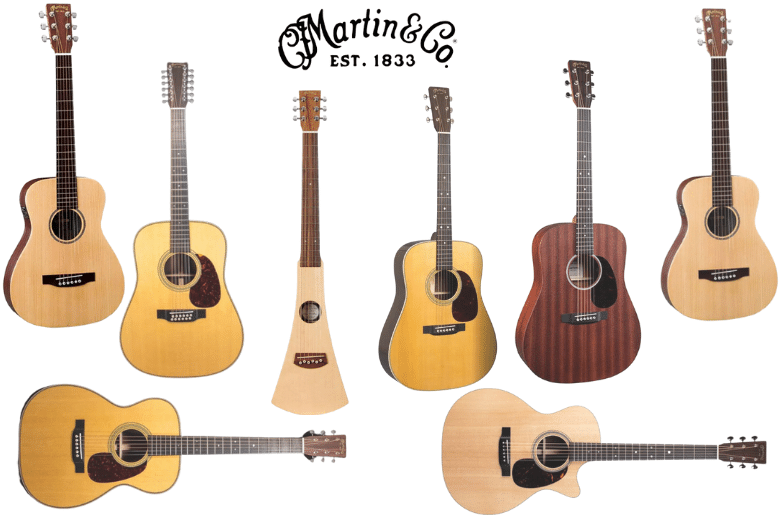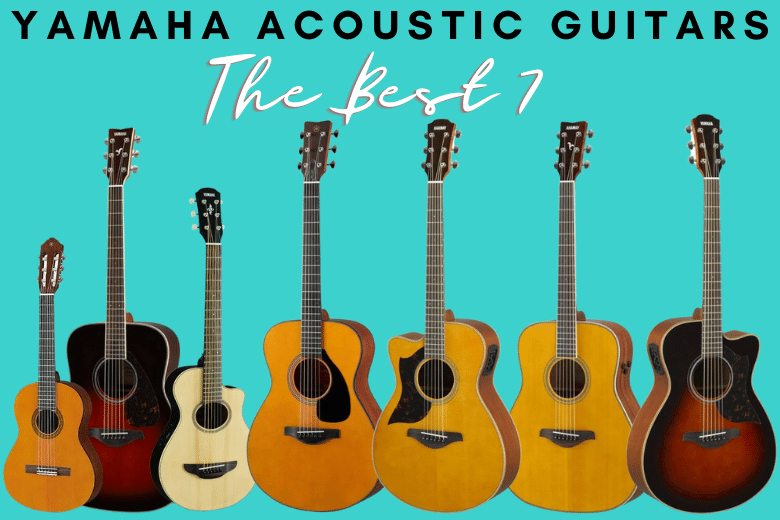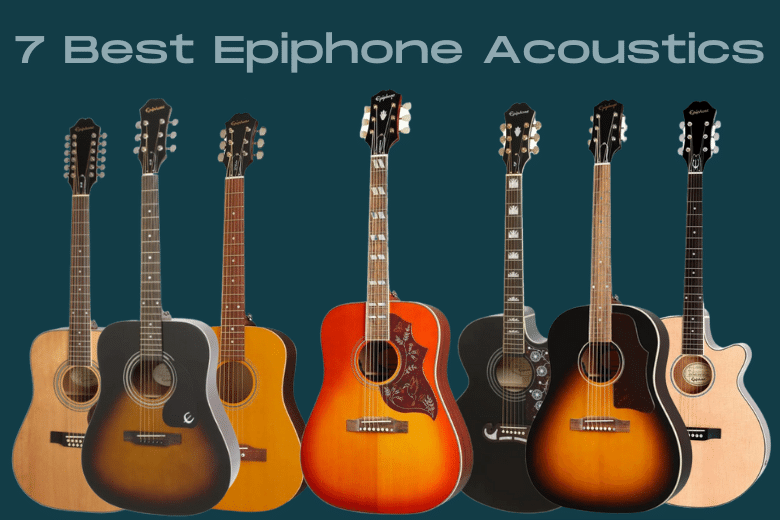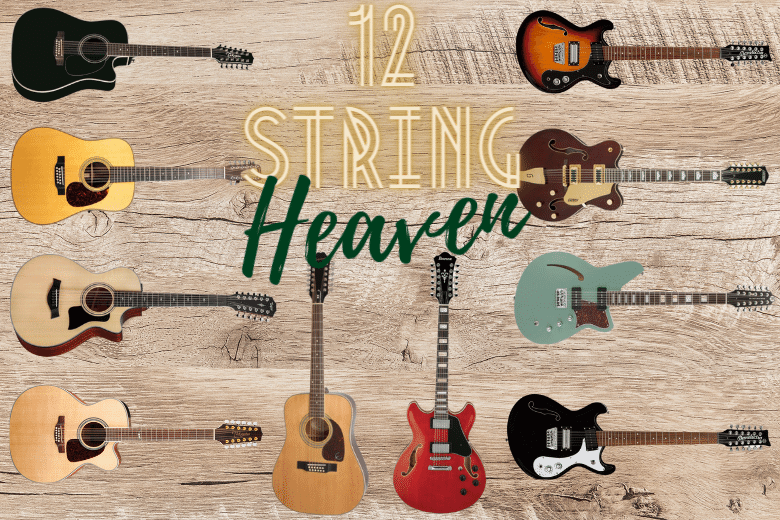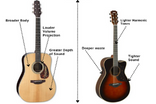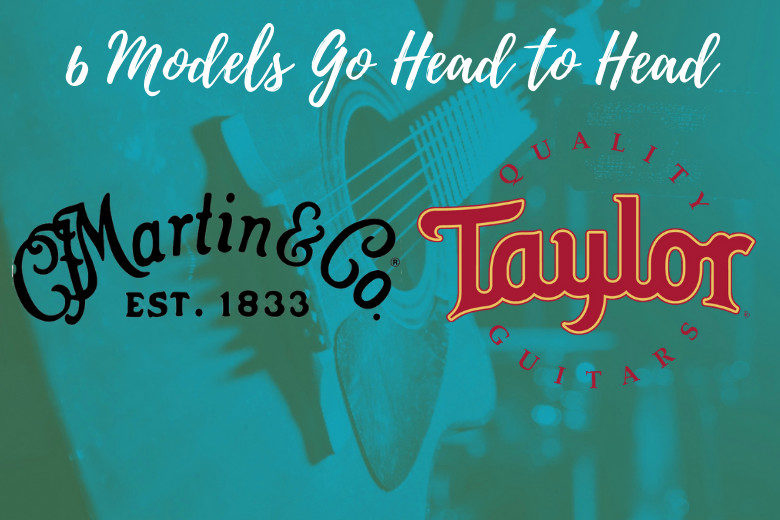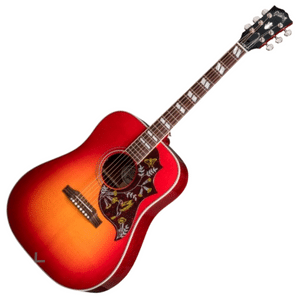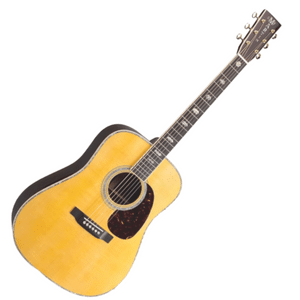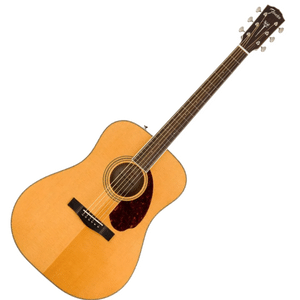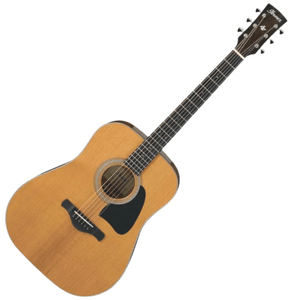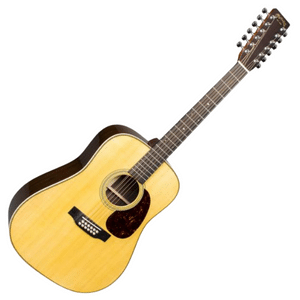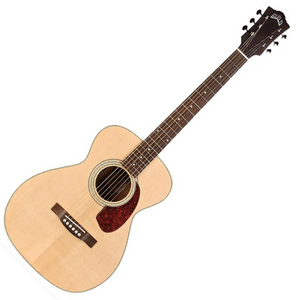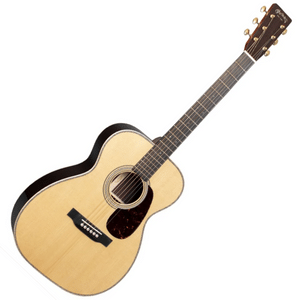Check Out Our Finest Acoustic Guitar Reviews
It’s good to get some real-life advice before buying any gear. Whether you’re interested in Martin, Epiphone, Fender, or Gibson Acoustic Guitar. Authority Guitar has reviewed some of the most beautiful guitars in today’s market.
Click on your chosen instrument to get the best reviews we have carefully put together to assist you.

Best Acoustic Guitar Review’s
Scroll down to see our favorite picks from each article
1- Gibson Acoustic Guitars
The Gibson Hummingbird is hailed as one of the best acoustic guitar designs all time. Its limited edition design ensures only the best quality craftsmanship and playability. Its mahogany neck features a Slim-Taper profile for optimal playability for any guitarist, no matter their skill level.
A solid Sitka Spruce top and mahogany back provide a warm, luxurious sound and excellent resonance.
The Hummingbird’s unique design produces a beautiful acoustic tone with great sustain. Every aspect of this instrument, from its graceful design to its elegant tonality, makes it an ideal choice for any musician looking for a stunning acoustic guitar.
Rich, warm tone: The Gibson Hummingbird is known for its balanced and rich sound, making it suitable for a wide range of musical styles.
Our Winner: Gibson Hummingbird Dreadnought
2- Martin Acoustic Guitars
Professional musicians revere Martin’s iconic D-41 dreadnought acoustic guitar. From Elvis Presley and Joni Mitchell to Michael Hedges, this elegant instrument has helped these stars craft unique sounds that have endured the test of time.
Expertly crafted with only premium East Indian Rosewood and Sitka spruce top materials and hand-carved deep scalloped bracings for a powerful sound, its neck also provides plenty of room—with 2-inch string spacing at saddle end—for sweet fingerpicking style playing.
Thanks to its precise balance in tone between treble sparkles over full bass tones, you can experience outstanding quality acoustics even if sometimes criticized for being too boomy!
Whether an amateur or veteran musician coming from any music background – Martin Dreadnoughts are a real treat not to be missed out on.
Our Winner: Martin D-41 Dreadnought
3- Taylor Guitars
The Taylor 214CE-DLX Deluxe Grand Auditorium is a top-of-the-line acoustic guitar that boasts exceptional sound, versatility, and stunning aesthetics. It’s a versatile instrument that’s perfect for strumming, fingerpicking, and flatpicking. The Grand Auditorium body style provides a balanced tone that’s bright and airy, with a strong mid-range punch, and clear, articulate treble notes.
The Deluxe version of this model is made with premium materials that enhance its tone, playability, and durability.
The solid Sitka spruce top and Indian rosewood back and sides are carefully crafted to produce a rich and resonant sound. The guitar’s sleek and elegant appointments include Indian rosewood binding, an ebony fingerboard, and an Italian acrylic inlay.
The cutaway design and onboard electronics make it a great choice for performers who need to amplify their sound, and the Expression System 2 pickups provide clear and natural sound quality.
The Taylor 214CE-DLX Deluxe Grand Auditorium is a guitar that truly stands out. Whether you’re a seasoned musician or just starting out, this guitar will provide you with a premium playing experience that’s unmatched. With its perfect balance of sound, style, and versatility, this is an instrument that you’ll love to play for years to come.
Our Winner: Taylor 214CE-DLX Deluxe Grand Auditorium
4- Yamaha Acoustic Guitars
The Yamaha FS Red Label FS5 is my favorite bang for buck guitar for many reasons.
Firstly, it has a comfortable guitar body shape (concert), perfect for players of all sizes and skill levels.
Second, the guitar has a Solid Sitka spruce top with a great tone and projection. In my opinion, an acoustic with little resonance and projection isn’t worth entertaining.
Thirdly, Yamaha’s A.R.E. is a process that uses heat, humidity, and atmospheric pressure to age wood. This results in a richer, vintage-quality tone for your instrument. So not only will your guitar age beautifully, but It will also sound better as the wood age accelerates.
Our Winner: Yamaha FS Red Label FS5 Concert
5- Epiphone Acoustic Guitars
The Epiphone Inspired By Gibson J-45 Acoustic-Electric Guitar is a stunning acoustic guitar that features the same finishes, signature details, and top draw specs as the popular Gibson J-45.
The tone is lush and well-balanced – perfect for any genre of music. In addition, the built-in electronics give you plenty of options for amplifying your sound.
With a solid low-end punch and sparkling bright tone, this guitar can handle any style of music you throw at it. So you can take your sound to new heights on stage with ease
Our Winner: Epiphone Inspired By Gibson J-45

6- Fender Acoustic Guitars
The Fender PM-1E Dreadnought Standard Acoustic-Electric Guitar is a beautifully designed acoustic-electro guitar with plenty of the original ‘Fender D.N.A.’
The ’60s checkerboard rosette and purfling, headstock shape inspired by the ’70s F series acoustics, ’70s bridge design, and late -40s-style Fender logo create a look that is both classic and contemporary.
This instrument is perfect for players looking for an acoustic with a bigger overall sound.
Our Winner: Fender Pm-1e Dreadnought Standard
7- Ibanez Acoustic Guitars
I like my acoustic to have a balanced tone overall, and a sound quality that’s not too ‘tinny.’
It’s nice to choose to bang out some chords or throw the pick away and sit up late, fingerpicking quietly. For this reason, I’ve gone with the Ibanez Artwood Vintage Avd60 as it seems to excel in most areas that I require.
The cost is also fair when you consider the materials used in construction. It’s also a dreadnought shape which I’m also used to. It’ll last you a lifetime which again is very important.
Our Winner: Ibanez Artwood Vintage Avd60
8- 12 String Acoustic Guitars
Martin company acoustic guitars have been the crown jewels for over eight decades. It’s difficult to say otherwise with owners ranging from The Beatles, Bob Dylan, Hank Williams, Johnny Cash, and Neil Young, to name a few.
They’ve remained faithful to their stunning playability, world class tone, and versatility. This should give buyers confidence when considering parting with their hard-earned money. In addition, you’re assured of a well-built, traditional-sounding style acoustic guitar.
The Martin HD12-28 Dreadnought Acoustic has top-notch build quality (as you would expect from a premium guitar builder).
Our Winner: Martin HD12-28 Dreadnought 12-String
9- 1/2 Size Guitar. 4-12 Years Old
Suppose you’re ready to step up from the nylon strings to the steel strings. Here is your first stop.
The Yamaha Jr2′s Mahogany finish creates a beautiful look that will turn heads wherever you go. It comes with a durable gig bag for transport too!
The JR2 Acoustic Guitar has a small body but a reliable one for songsters just learning their way around the instrument.
The curved neck and body shape conspire to produce a tone that can project through any venue, even in small acoustic spaces.
Our Winner: Yamaha Jr2 Acoustic Guitar
10- Best Low Priced Fingerstyle Acoustic Guitar
This Guild M-240e model offers superior balance with a delicate tone and is easy to play. It ships with a lightweight Guild case.
This guitar design features a fingerboard and bridge made of Indian rosewood as well as bone nut and saddle. It also displays a mother-of-pearl rosette and a tortoiseshell pickguard.
In addition, this model exhibits the Guild Chesterfield headstock emblem that appeared on models in the 1960s. It is currently available in the Natural gloss finish.
Comes fitted with a Guild/Fishman Sonitone GT-1 Preamp System
Our Winner: Guild M-240e Concert Size
11- Dreadnought Vs Concert Acoustic Guitars
The stunning ‘Taylor Builders Edition‘ is Royalty of the Concert acoustic guitar world. For players with exquisite taste. A real treat for the guitarist looking for a first-class ride.
They are crafted from top-notch rosewood and solid spruce top. The frets are a shorter 24-7/8″ scale length. This gives you a smooth and slinky way of moving around the fretboard without having to try very hard.
Incredibly responsive to touch while offering an incredible sustain and mid range warmth.
Our Winner: Taylor Builder’s Edt 912ce Grand Concert
12- Martin Vs Taylor Acoustic Guitar Battle
The Martin 00-28 Grand Concert Acoustic Guitar is another accomplished masterpiece.
Once again, Martin shows off their legendary luthiery skill with a concert sized guitar. A perfect combination of classic acoustic guitar tones and from the modern thinking guitar manufacturers.
The top-end shimmering tone is a joy to the ears. You cannot get this attribute from any other guitar around this price. In addition, the scalloped bracing provides excellent resonance and superb projection.
Our Winner: Martin 00-28 Grand Concert
Check Out Guitar Tonewoods
Experience Sound Quality and Playing Ease of Different Guitar Tonewoods
When you shop for a new acoustic guitar, explore the different tonewoods. Discover how they affect the overall tone, sound quality, durability, and playing ease.
Whether you are buying your first acoustic guitar or replacing an older, worn model, you want a new instrument that is skillfully designed. Yet, you are seeking a beautiful new instrument that fully satisfies your current playing abilities, desires, and needs.
Responsible guitar sellers encourage buyers to play different models before buying a new guitar. Try and experience every guitar’s tone.
Some sellers have good knowledge of the tonewoods, their strengths, and their weaknesses. Yet, for the best results in choosing your ideal new guitar, you should have this information at your fingertips.
Here’s our in depth guide on acoustic guitar tonewoods.
What to Know About Guitar Size
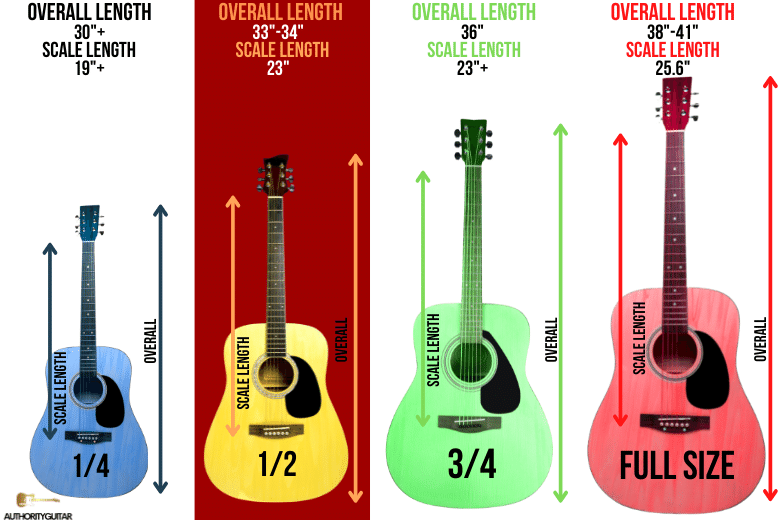
Know Acoustic Guitars Body Shape
The three most frequently purchased guitar body types:
• Dreadnought Body
If you’re looking for a balanced tone with plenty of power but without being too harsh or tinny, this is the body type for you. The deep bass resonance will fill up any room. While still providing clear bright tones when needed to cut through a mix! It’s perfect for a live performance on stage or having some fun at home.
This type may not be suitable if you’re looking for the higher-spectrum and fingerpicking style sounds.
• Grand Concert
The Grand Concert is a smaller-sized guitar that’s ideal for fingerstyle. The sound it produces has more mid range and doesn’t boomy or overpowering like many other guitars do when played by people who sit down to play them.
The tone can be pleasing even if seated because of its attractive shape and super resonant shape.
• Grand Auditorium
You can’t go wrong with a Grand Auditorium for acoustic guitar comfort and ease of playability. The proportions of this instrument are between those found on both the Concert and Dreadnought ranges – meaning that it offers quality balance across all tonality levels! It’s perfect for fingerstyle play and strumming techniques, whatever your preferred style.
Many experienced players recommend choosing a guitar designed with a cutaway, especially if you’re a beginner or intermediate. This player-friendly shape enables you to access the entire fretboard easily, including the higher frets.
‘How’ to Select Your Ideal Acoustic Guitar
To select the ideal guitar that is best suited for great fingerstyle playing, you may want to focus on the following advice and tips:
• Playability.
When you are looking to buy a new guitar, audition it. Try playing the entire neck with songs or compositions you know so well, and make sure there is no fret buzz before committing! Is the guitar a snug fit in your lap? How’s the neck width for your reach?
• Tone Quality.
Does it produce a clear sound projection with color and volume when you play the guitar? Listen closely to any strings that rattle. If there’s something amiss, even the tiniest issue question it. Guitars are set up in minute increments and have to be near perfect to play correctly.
• Tuning Quality.
One of the most important things to look for when buying a guitar is ensuring that it stays in tune and have the frets have been set up correctly? Is the neck straight (there should be a slight bow, NOT a bend)
Guitarists are often faced with the challenge of tuning their instruments constantly; this can be a massive chore if you have an issue. So it’s essential you make sure your new guitar stays in tune (most of the time!)
Be aware that the guitar will probably inherit problems without making adjustments accordingly by professionals every few years. After years of heavy use, every guitar needs to be checked over by a guitar tech. Guitars are made from wood; wood is organic, and it expands and bends over time.
What To Think About As A First Time Buyer
If you are a first-time buyer, it is essential your acoustic guitar is the right size and weight for your body. Also, consider the length of time you will be playing each day. Being uncomfortable for most of your practice time will drive you to quit very quickly.
As an option to this rule of thumb, consider lighter-bodied guitars with shorter necks for complete beginners. This will ensure the strain on your wrists is much more manageable.
It can be hard to know what size guitar is right for you; here are some pointers to help you with that:
The body type and shape of the instrument will dictate how well it fits you.
Additionally, consider what type/style of acoustic will work best for your body shape and age—especially for children. See my chart below
| Age | Height | Guitar Size | Total Guitar Length |
| 4-6 | 1.04 to 1.14 m | 1/4 | 30′ |
| 6-9 | 1.14 to 1.30 m | 1/2 | 34′ |
| 9-12 | 1.30 to 1.42 m | 3/4 | 36′ |
| 10-12 | 1.44 to 1.60 m | 7/8 | 38′ |
| 12+ | 1.60+ m | Full | 41′ |
The smaller the guitar, the easier it is to hold and play. But unfortunately, this also means that you’ll have a shorter scale length with less fret space to play around with. So learning certain chords or melodies may be more challenging than if your guitar had larger dimensions.
More expensive guitars have been set up, so the guitar is playable right out of the box. A guitar set up to specific measurements is best for nearly all guitarists unless you have vast experience doing it yourself.
Your guitar’s action is how high or low the strings sit in relation to the frets.
Here’s a brief description of the three actions readily used:
Low action is excellent for beginners because the strings are close to your fretboard, making it easier to learn and superb for players who want to play faster.
Medium action is a safe place to start until you know what genre you will be playing. Medium height is what most retailers set their guitars up at.
High action setup measurements are much farther from your frets. So, naturally, this makes it more challenging to play. But, higher setups can provide great tones depending on what gauge strings you’re using and who is playing them!
The string gauge is a crucial aspect of any musical instrument. The string gauge can affect how hard you need to press down and what kind of sound you’ll receive when being played. So make sure your strings suit your finger strength and the music you are trying to achieve.
A light to medium string action is ideal for those just starting out. These are 9 and 10-sized strings gauges. These gauge sizes aren’t too difficult to play each note properly, and you won’t need to build up fingertip calluses to succeed.
I would also add nylon string guitars into this category. Classical guitar body shape is very friendy on the fingers.
Neck width- it may be more comfortable to use an instrument with a wider than usual fit because your hands will feel less cramped when you play!
In contrast, narrower necks can also make playing easier on beginners’ fingers as they don’t have any excess space to fill, and fretting is much less of an effort.
When you’re looking for a new guitar, price is definitely going to be one of your main considerations. An excellent beginner instrument can be purchased anywhere from $200-$500 depending on the level of player and quality that best suits their skill set!
Be aware that anything below this price is probably a toy! Stay away.
Get The Right ‘Feel‘
Being comfortable and at ease is a huge benefit when playing guitar. The last thing you need is an ill-fitting guitar giving your wrist pain. It all boils down to how well your instrument feels in your lap, and in the palm of your hand. Is it too long, too narrow?
Whether you just paid $3500 for a top-end acoustic guitar or not, if it’s not been set up properly, then chances are that it won’t sound anywhere near $3500 worth of acoustic. And nothing will make playing more difficult than fighting against an instrument that doesn’t suit the player’s skillset or strength. This even applies to pro players.
When you first start playing the guitar, your instrument should be kept in top condition. Allowing a guitar to bow too much or warp could lead to some serious consequences later on down the road.
A good setup will help prevent any wrist, arm, or finger pain from occurring. Learn how this wonderful musical device works best with our hands – especially after picking up an inexpensive secondhand model without properly adjusting its action.
How Much Do You Spend?
Acoustic Guitars Price Chart Breakdown; Approx Costs
- Starter Kits $100-$200 (Children, Entry Level)
- Beginner Guitars $200+ (Larger Children, Beginners)
- Standard Guitars $600-$1200 (Beginner, Intermediate, Hobbyist, Pro)
- Top End Guitars $1400+ (Pro, Performer, Studio Work, Enthusiast, Collector, Perfectionist)
- Used Guitars -If Useable Up To-50% Off New Price
The world of guitars is vast and overwhelming, with prices ranging from $50-$6000 (and more for custom build quality!)
It can be hard to know how much to spend!
Beginner guitarists often ask the question-‘How much should I spend on a guitar?’ ‘How much does the average guitar cost? ‘
If you’re a total beginner, buying an expensive guitar is not the best idea. Most beginners won’t be able to play it due to the setup or specific build quality. It’s also not cost-effective if the player decides it’s not for them.
Some top-end guitars are built around a specific type of player. I.e., Fingerpicking, Heavy Metal, Blues, etc., etc.
While real cheap guitars can come at a low cost, you may be sacrificing quality for price.
A common concern among those just starting out in music and performance has been whether purchasing an expensive model makes more sense than buying something cheap.
The truth? It doesn’t matter what type of guitar you choose. There is no shortcut to learning an instrument; you will need to practice many hours to receive any model’s full potential!
It can be hard to know exactly what makes a ‘suitable’ guitar for your personal scenario.
Our article below goes into detail and will answer all your questions about how much you may want to spend when considering your skill level.
Why Investing In A Good Acoustic Guitar Can Make A Difference?
Investing in a good-quality acoustic guitar is an investment that will pay off. You’re getting something beautiful, well built, and durable – not to mention a much better-sounding guitar that will make you want to play more and more.
An acoustic guitar’s rich sound and beautiful appearance make it a popular choice for many musicians. In addition, a well-made instrument can be passed down through generations. Solid wood models provide more depth than other materials such as laminate. Laminate or stacked wood is used in lower-priced guitars.
When buying any musical instruments and accessories, it’s important to think about what appeals to you and factors like the price point. Of course, the cheaper something generally means lower quality, so don’t expect it to last as long!
In terms of playability, a good-quality acoustic guitar will be much easier to play than a cheaper, lower quality model. This is because high quality guitars are made by hand with better attention to detail and superior materials. This gives the player a far better playing experience.
So, suppose you are looking for an acoustic guitar that is both comfortable to play, and sounds fantastic. In that case, it is worth investing in a decent model.
How Do You Get Chemistry With An Acoustic Guitar?
There is no one-size-fits-all answer to this question, as the best way to get chemistry with your guitar will vary from player to player. However, some general tips below can help you find the right guitar.
Tips:
It is important to have a clear idea of the style of music you want to play. It’ll help narrow down the search for the ideal model.
For example, if you are looking to play country music, you will want an acoustic guitar with a bit more twang than if you were playing rock or blues. Maybe a guitar with a bigger body for those lush open chord tones.
Once you have an idea of the type of guitar you need, it is important to try out as many different models as possible. This will help you get a feel for each guitar and how it responds to your playing style. Every guitar shape is different from the next.
It is also important to keep in mind that the best guitar for you may not be the most expensive one. For example, I have a $700 acoustic I’ve played for 12 years because it matches my style perfectly.
A guitar will generally fit you like a glove once you find the right one. It feels natural to play and sounds good no matter what you do with it.
If a guitar does not feel comfortable from the outset or sounds bad to your ear, no matter how you try, that’s enough to tell you it is probably not the right guitar for you.
What Is A Guitar Player Profile?:
Figure out your player profile; this way, you can narrow down your buying options. This gives you a better chance of purchasing the ideal acoustic guitar.
Try it now:
- What Is Your Acoustic Guitar Playing Style? Blues, Rock, Country, Fingerstyle, Lead
- What Type of Music Do You Like To Play? Look at what your heroes play to get an idea of genre
- What’s Your Skill Level? Do you consider yourself a beginner, intermediate, or advanced guitar player? Be honest, as you won’t need a fingerpicking guitar until you can execute the style correctly.
Once you know your profile, it will be easier to find the correct guitar, amp, and accessories to suit your needs. It will also help you better understand the types of songs and techniques within reach, considering your current skill set.
Knowing your guitar player profile is helpful and something to consider before buying an acoustic guitar.


